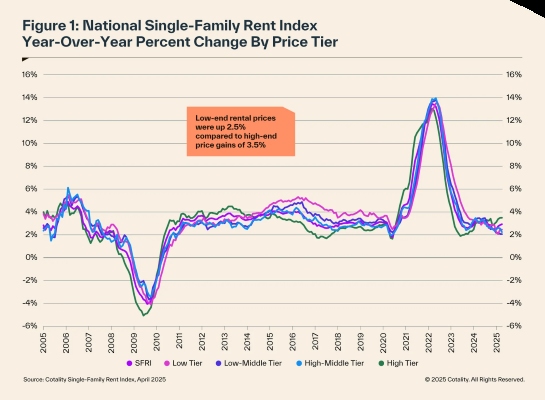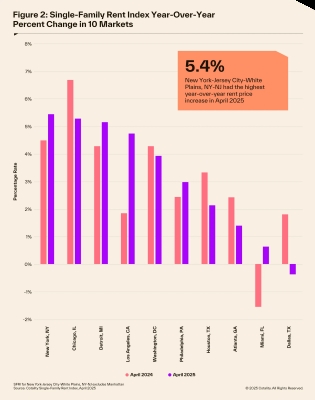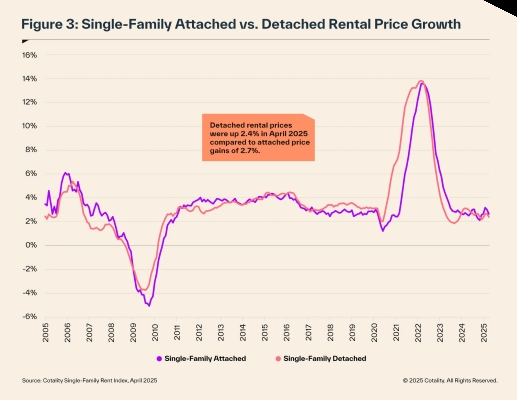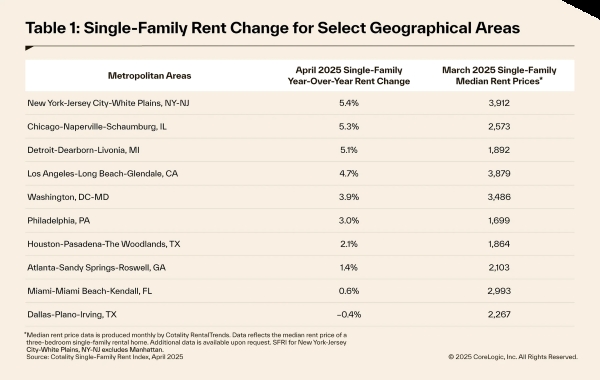U.S. Single-Family Rent Prices Increased 2.9% Year Over Year in April 2025
The New York metro area moved to the top of the list for April’s highest annual rent growth, followed by Chicago and Detroit
Los Angeles fell to the fourth-highest rent growth as the demand from the January wildfires dropped
Dallas single-family rents fell year over year for the second consecutive month in April
Cotality, a leading global property information, analytics, and data-enabled solutions provider, released its latest Single-Family Rent Index (SFRI) for April 2025, which analyzes single-family rent price changes nationally and across major metropolitan areas. Single-family rent prices in April 2025 increased 0.8% from the previous month, slightly faster than the 0.7% increase last year or average April change before the pandemic.
Compared to last April, rents were up 2.9%. Last year at this time, annual rent increases were growing at 3.1% before slowing at the end of 2024. Now, prices are trending back up to the pre-pandemic growth rate of 3.4%.
“Annual single-family rent growth mostly moved sideways in April, increasing by 2.9% year over year for the second consecutive month. Rents increased the most in the Northeast, Midwest, and Mid-Atlantic. They increased the least in the South, which is a similar pattern to home price growth. This could be an indication that the limited supply of for-sale homes, which is pushing up for-sale prices, is spilling over into the rental market as would-be buyers remain renters,” said Molly Boesel, Cotality senior principal economist.
Rent prices for high-end properties increased 3.5% year over year in April 2025, an acceleration from the year-over-year gain of 3% in April 2024. Low-end rent prices increased 2.5% year over year in April 2025, which is a drop off from the gain of 3.2% in April 2024.
Rent for detached rentals grew by 2.4%, and attached rental rates rose 2.7% in April 2025.
New York-Jersey City-White Plains, NY-NJ saw the highest rent growth, moving to the top of the SFRI at 5.4% in April 2025. It was followed closely by Chicago at 5.3% and Detroit at 5.1%. Los Angeles dropped to the fourth spot after topping the list for two months following the January 2025 wildfires. The lowest rent price growth in the nation was in Dallas where rents continued along a negative trend of -0.4% decline in April. The area continues to see increases in overall rental supply. Rent growth continued to stay low in Miami at 0.6%.
The next Cotality Single-Family Rent Index will be released July 17, featuring data for May 2025. For ongoing housing trends and data, visit the Cotality Insights blog: www.cotality.com/insights.
Methodology
The Cotality Single-Family Rent Index (SFRI) applies a repeat pairing methodology to single-family rental listing data in the Multiple Listing Service. The rental listings used to calculate the index include both attached and detached single-family homes, as well as condominiums. This report shows trends for the U.S. and the largest 10 U.S. metropolitan areas. In addition to these 10 metros, the Cotality SFRI is available for close to 100 metropolitan areas — including approximately 47 metros with four value tiers — and a national composite index. The indices are fully revised with each release to signal turning points sooner.
The Cotality Single-Family Rent Index analyzes data across four price tiers: Lower-priced, which represent rentals with prices 75% or below the regional median; lower-middle, 75% to 100% of the regional median; higher-middle, 100%-125% of the regional median; and higher-priced, 125% or more above the regional median.
Median rent price data is produced monthly by Cotality Rental Trends. Rental Trends is built on a database of more than 11 million rental properties (over 75% of all U.S. individually owned rental properties) and covers all 50 states and 17,500 ZIP codes.
About Cotality
Cotality accelerates data, insights and workflows across the property ecosystem to enable industry professionals to surpass their ambitions and impact society. With billions of real-time data signals across the life cycle of a property, we unearth hidden risks and transformative opportunities for agents, lenders, carriers and innovators.
Source: Cotality™





